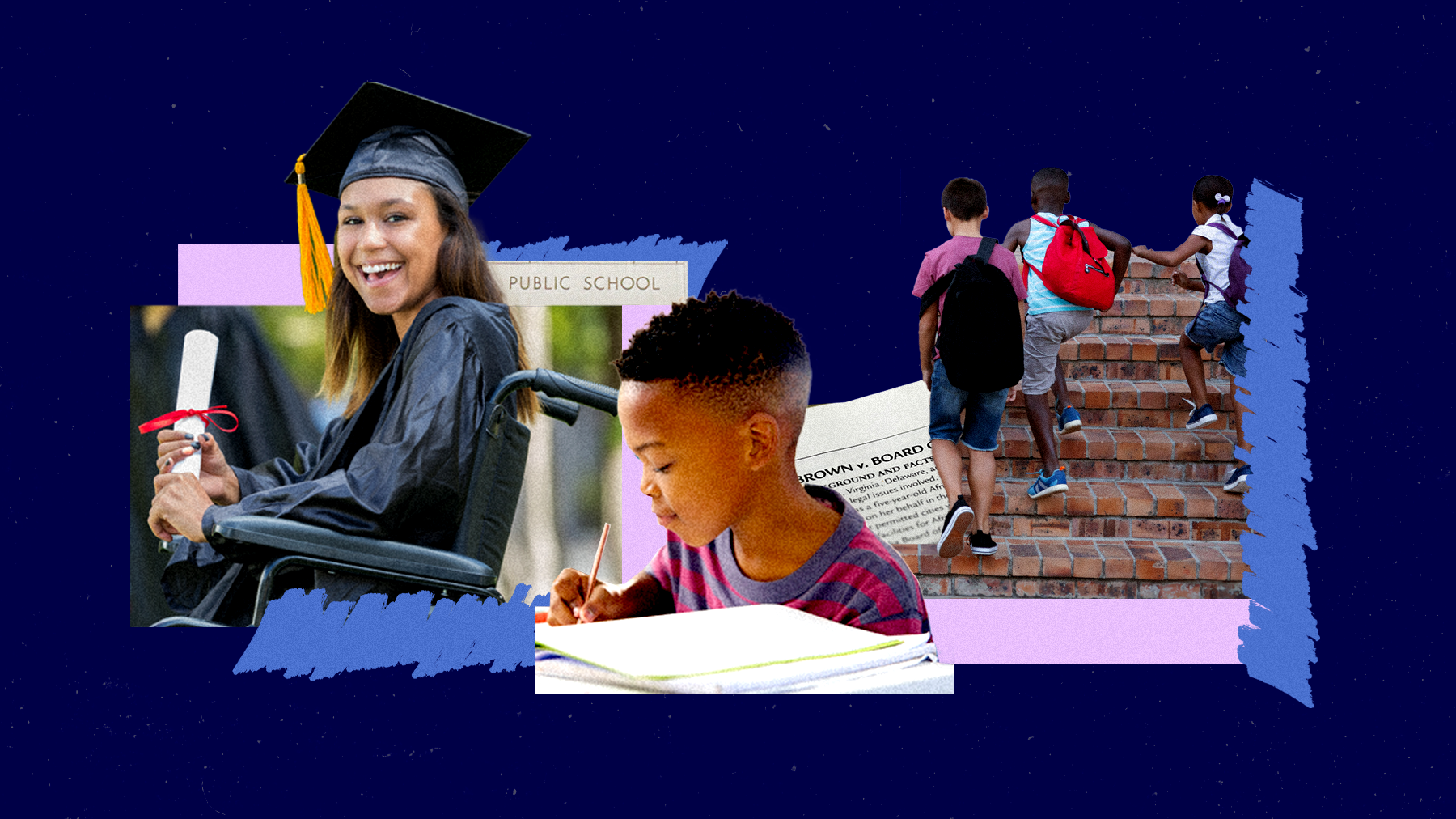In sum, the labels assigned to schools — particularly public schools by politicians seeking to defund them — should be approached with caution.
The United States has a history of labeling schools as “failing.” When the Soviet Union launched the Sputnik satellite, American schools became a scapegoat for our having “fallen behind.” And in the 1980s, the Ronald Reagan administration’s A Nation at Risk report blamed “failing schools” for the nation’s problems and its place in the global economy. Today, schools are being blamed for “indoctrinating” students into “woke” ideologies, all the while “failing” when it comes to academic outputs. International comparisons indicate the U.S. regularly ranks low among other industrialized nations in math and reading scores — though wealthy students in the U.S. perform at the top, indicating that we have a wealth inequality problem, not an education problem.
For many politicians, these results represent the rationale for dismantling public schools in favor of private options (to the financial benefit of those private schools, of course). But what goes into the process of labeling schools, and how reliable are those labels — especially when a school is labeled as “failing”?
How Is Education Success Measured?
Measuring and interpreting academic data to conclude that learning is, or is not, taking place is done in myriad ways. From a large-scale perspective, the National Assessment of Educational Progress (NAEP), known as the nation’s report card, represents the largest nationally representative evaluation of schools in the U.S. Students in grades 4, 8 and 12 take the NAEP exams across varying content areas every two years. Numeric results are reported but categorized along four labels: (1) Below Basic, (2) Basic, (3) Proficient and (4) Advanced. Historically, and across all content areas, approximately 30% to 40% of students fall into the Below Basic category, 30% to 40% in the Basic category, 20% to 30% in Proficient, and 10% in Advanced.
When the NAEP results are released, they are often misrepresented in the media, with some variant of the claim “only 20% of students in the U.S. scored Proficient” and then a discussion of how public schools have “failed.” Given the chosen labels associated with the four levels, a surface-level analysis might lead someone to conclude that many of our nation’s students are failing. However, the labels themselves are misleading and do not convey the low-performance results suggested on the surface.
When understood in a more appropriate and recognizable scale, the levels of achievement are as follows:
NAEP Level Letter Grade Level Percent of Students
Advanced A+ 10%
Proficient A to A- 20% - 30%
Basic C 30% - 40%
Below Basic D to F 30% - 40%
(Adapted from Diane Ravitch’s Reign of Error: The Hoax of the Privatization Movement and the Danger to America’s Public Schools.)
According to NAEP, “Proficient” demonstrates “solid academic performance and competency over challenging subject matter,” and NAEP further notes that “Proficient achievement level does not represent grade level proficiency as determined by other assessment standards.” That is, “Proficient” is not synonymous with being on grade level, as state or district assessments measure, but represents achievement above and beyond.
This is not to suggest that the nation should shrug its shoulders and be content with 30% of students scoring a relative D, but it does help put what achievement actually looks like into perspective, with a labeling terminology that most of us understand.
In total, 70% of students in the U.S. are performing as we would expect them to perform despite increased rigor and content complexity over the decades. This paints a different picture from how the media and school-privatization cheerleaders use the NAEP results to call for ending public schools and replacing them with paid memberships in private schools.
Misleading labels can, on the surface, give the impression that public education is not going well in the U.S. However, education is certainly better than media and politicians favoring privatization would suggest, with vastly improved access. In 2021, 91% of adults in the U.S. age 25 and older were high school graduates, which represents an increase from 70% in 1981 and 34% in 1950. Digging a bit deeper into the labels, it is easier to understand that the U.S. has less of an education problem and more of an income inequity problem.
International Comparisons
Similar to NAEP, the Program for International Student Assessment (PISA) measures academic knowledge for specific subject areas comparatively on an international scale. With similar results, media and politicians often claim, again, that the U.S. is “failing” compared to other nations as we rank low among the nations who participate in the PISA. In both tests, and the resulting labels, if we control for the socioeconomic status of students (e.g., only comparing public school students with similar household incomes to those of private school students), the U.S. often scores at the top (usually #1) across content areas.
What this tells us, then, is that the U.S. does not have a schooling problem in which the vast majority of our schools are failing; rather, we have a systemic problem with income inequality and the poverty that follows, which affects education. And while the PISA is held up as an exhibit of measuring achievement, only 4,552 students in the U.S. participated in 2022 (below the required participation rate), which further indicates the test may not be a good instrument in the way it is being used.
Misrepresentation of ‘Failing’ Public Schools and the Push for Vouchers
Parties with an interest in advocating for school “choice” schemes such as vouchers have long used and misrepresented NAEP and PISA results, along with a litany of other standardized testing outcomes, as “proof” that public schools are failing and that a market-oriented approach to education should be created to spur improvements. They have also specifically claimed that policies like vouchers could help students experiencing poverty who are attending “failing” schools gain entry into private schools to improve academic opportunities. This, of course, purposely neglects that even with a voucher, gaining a membership with a private school remains the choice of the school and often comes with exorbitant costs well above what the voucher covers.
Research over the past decade has found that students who use vouchers to attend private schools perform worse academically than their public-school peers. When the chosen metric of test scores used by school “choice” advocates did not bolster their claims, they simply moved the goalposts to other metrics in a never-ending quest to find justification.
Understanding the Metrics for ‘Failing’ Schools
These labels are often an intentional effort to blur the lines by using hyperbolic terms like “failing” to elicit an emotional response to soften the ground for privatization policies that would otherwise not find root.
Voucher schemes often employ questionable uses of labeling schools as “failing” to justify and expand voucher use, which results in financial gain for some and loss of funding for public schools.
In Georgia, for example, the first requirement for a voucher to help offset some of the costs associated with a membership at a private school was that a student must currently attend a public school that ranks in the bottom 25% of all schools in terms of academic performance. A current exception to this is for rising kindergarten students. But what does that mean, and how is ranking determined?
The Georgia Education Savings Authority (through which tax money passes so the state government is not “directly” funding religious schools) recently expanded the qualification parameters. Students now need not attend one of the “failing” schools but simply need to be in the same feeder system of the “failing” school. That is, if a student who is attending a high school where one of the feeder elementary schools is listed in the bottom 25%, then the high school student would be eligible for the voucher despite there being no direct impact of the elementary school’s ranking on the high school student’s experience.
Exploring the labels and definitions being used here to qualify “failing” schools or schools “ranking at the bottom” is therefore important. On a cursory glance, being labeled as the “bottom 25%” can give the impression that the schools are failing, are posting low academic outcomes, and are, overall, undesirable schools that should be avoided. It is vital to understand, however, that no matter the educational performance of any school system, district, state or an entire nation of schools, there will always be a “bottom 25%” because that is simply how math works. For example, if the heights of all residents of Georgia were measured and charted, there would be a “bottom 25%” in terms of height just as there would be a “top 25%.” While the top 25% of schools in terms of academic performance do outperform schools in the bottom 25%, the fact that there is a bottom 25% does not automatically mean that the schools in that category are failing.
Consider this example of four hypothetical schools with their associated average grade out of 100% on a test:
- If four schools scoring 99%, 98%, 97%, 96% respectively are ranked, the school whose students scored 96% would be ranked the “bottom 25%.”
- The difference in scores between the school in the top 25% and the one in the bottom 25% doesn’t have to be substantially large.
- Because we are ranking, there will always be a top and a bottom percentage, no matter the actual score difference.
This is not to suggest that there are no schools with low academic performance (in Georgia or elsewhere) but simply shows that the chosen metric of “bottom 25%” does not necessarily tell us much about the actual performance of the schools in question, as there will always be a “bottom 25%.” What it does illustrate is the aim of manufacturing a “bottom” and therefore, a need and demand for vouchers. If vouchers to help offset the costs associated with a membership at a private school are always available to the “bottom 25%” of schools simply because they are the “bottom 25%,” then there will always be qualifying schools regardless of the actual academic outcomes at those schools.
More to the point, the recent expansion of qualification to include any student in a cluster of schools (elementary > middle school > high school) expands the qualification pool significantly even when a student does not attend the school that is in “the bottom 25%.” In fact, in the example discussed above, it is entirely possible that elementary school X (that feeds into high school Y) could be in the “bottom 25%” of elementary schools while high school Y itself is in the “top 25%” of high schools. Yet, given the expanded definition of who qualifies, a student at high school Y would be eligible for a voucher simply because elementary school X is in the “bottom 25%” even if the student never attended that elementary school — or did, but three to seven years have passed since the student was in that elementary school.
In sum, the labels assigned to schools — particularly public schools by politicians seeking to defund them — should be approached with caution. Nebulous labels that use phrases and words that mean one thing in common parlance may not (and do not, as noted above) carry the same meaning when applied to schools. These labels are often an intentional effort to blur the lines by using hyperbolic terms like “failing” to elicit an emotional response to soften the ground for privatization policies that would otherwise not find root.
While U.S. public schools still have a way to go in terms of providing equitable opportunities for all students, they represent the best mechanism through which that aim can be realized. And incredible progress continues to be made as more students are graduating high school and attending and graduating from college, which bolsters our communities and our nation. Data indicates that since the establishment of the U.S. Department of Education as a Cabinet-level federal agency in 1980, education access has steadily improved. And in 2021, the total U.S. population age 25 and older who had completed a bachelor’s degree or higher was 37.9% (compared to 17% in 1981).
Do not be misled by school-labeling schemes that attempt to put a thumb on the scale in a covert effort to defund schools and privatize them such that only the affluent benefit.
Read More
Public schools are an ideal and vital mechanism to achieve a thriving democracy. The current efforts to dismantle public education (and our democracy) include removing vital resources from public schools.

Read the other two articles in this series on public schools as a common good, examining possibilities and threats.
Why Public Schools Matter

School Vouchers and the Efforts To Undermine Public Education
Reflection and Action
- Consider how the current federal government’s funding cuts to the U.S. Department of Education’s Institute of Education Sciences (IES) (the office with the mission to “provide rigorous evidence on which to ground education practice and policy”) can affect the ability to collect reliable education data. How can the lack of reliable data lead to misrepresentations about public schools and further the agenda of those seeking to label public schools as “failing”?
- How is the emotional connotation of “failing” schools being used to justify voucher programs that funnel public taxpayer funds to private organizations with little to no oversight? How will this affect public schools in your community?
- Research the how your community schools are being labeled. What criteria is being used? What questions might you ask about school labels to your local school board or elected officials?

Take action: Join us in advocating for public education that fosters excellence and equity. Learn more with Learning for Justice’s “Advocating for Public Schools” resource.
Resources
Join us in advocating for public education that fosters excellence and equity. Learn more and take action with these resources:
- Advocating for Public Education (Learning for Justice)
- Understanding the Role and Responsibilities of the Department of Education (Learning for Justice)
- Issue Explainer: Vouchers (National Education Association)
- The Fiscal Consequences of Private School Vouchers (Public Funds Public Schools)
- Inequity in School Funding: Southern States Must Prioritize Fair Public School Spending (Education Law Center)
- Miles To Go: The State of Education for Black Students in America (Southern Education Foundation)
- Interactive Tools (Public Funds Public Schools)
- Voucher Bill Tracker (Public Funds Public Schools)
- Florida Private Education Vouchers Cost $4 Billion This School Year (Education Law Center)
- Action Kit: Stop Closing Public Schools (Advancement Project)
- The Dangers of Private School Vouchers for Idaho Students, Schools, and Communities (Public Funds Public Schools and Idaho Center for Fiscal Policy)
- How Vouchers Harm Public Schools (Economic Policy Institute)

Demanding Excellence and Equity
Education Justice Series
Public education is an essential common-good service and a cornerstone of democracy. This series can help us recognize damaging policies and practices and formulate strategies to ensure equitable public education.

